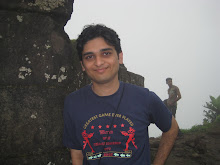This semester, I got a chance to read some books from our library. Unlike previous course-loaded semesters, this time I got the luxury of doing something I always long for. Many of the Mr. Poirots and Miss Marples or even Tuppences which I had read earlier were quite blur...so..I read almost all of the Agatha Christie available. An amazing marathi play 'Khara Sangaycha Tar..' which is based on 'Witness for the prosecution' still remains on my reading list though. William Dalrymple's book on mughals, Lala Lajpatrai's Shivaji were some of the books on my issued list. A book which I enjoyed for most of the time was 'A Suitable Boy' by Vikram Seth. Part of the reason was the amount of time taken to finish the 1300+ pages. I guess it took me around 30% of all my reading time this sem. As the book is based on the day-to-day life of a few families probably its best if it is read in small steps...just like a TV soap.
I have always wondered where would I go if I were given a time machine. I would probably have visited the magnificient hall of a king...may be his coronation ceremony....or may be obtain a bird's eye view on the Battle of Thermopylae....or may be see the glittering city of Tenochtitlan just as the Spanish conquistadors did. But after reading this, I would have wanted to visit the just-independent India. An era when everything was new, everything was developing, when entire country was transforming. Ofcourse there were own set of post-partition problems, but there was an air of freshness around. Rather than being just an answer for 'Who is our first prime minister?', Pandit Nehru would have been governing the nation.
Going with the title, it is but obvious that an Indian arranged marriage system would be depicted. But the important part according to me is the era in which this story is set. I was amazed by the imagination of the author to depict the details of urban as well as rural life in India in very early 1950s. The story revolves around Lata, a middle-class girl for whom a suitable boy is being searched. Along comes the narration of Lata's family- the Mehras, the affluent Chatterjis, the freedom fighter turned politician Mr. Kapoor's family. A glimpse of all factors existing during that time is cleverly put on by the author. For e.g. the existence of Nawabs, the zamindari issue, the caste problem, partition grievances, the existance of courtesans and pompous princely states. Several events which have been happening for generations like the Kumbh mela, election campaigns are handsomely written for this time period.
Each character in this book is unique. Lata the middle-class girl with hopes and aspirations, bold Malati, reckless but soulful Maan, hardworking and ambitious Haresh, serene and calm Pran, wicked Prof. Mishra, bubbly Kakoli, spiritual Dipankar, poetical Amit, arrogant Arun and the list goes on.
An interesting thing I always do while reading a book is searching for a character which epitomizes the author and I have been successful almost everytime. In this case though, I thought the author would share qualities of both Amit and Dipankar.
Anyways the bottomline is that this is an awesome book and would recommend it strongly.

No comments:
Post a Comment